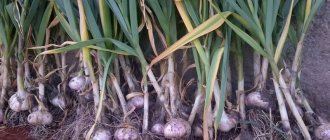Storage methods
Each vegetable has its own storage conditions that will be favorable for keeping quality, and in general, such rules are similar to most root vegetables.
In practice, it has already been proven that beets are much easier to store than potatoes or beets (Figure 5). Among the main methods of storing beets are:
- Combined storage with potatoes: scatter the beets in an even layer on top of the potatoes in the box, which will create favorable conditions for both vegetables. Potatoes prefer dry conditions and can quickly spoil in a humid environment. At the same time, beets need a little more moisture than most crops. Under such conditions, the burgundy root vegetable will feel good, but it will also take away excess moisture from the potatoes, which is harmful to it.
- Storing beets in boxes with holes: burgundy root vegetables are poured into small wooden or plastic boxes. It is not recommended to cover the boxes, as the vegetables must be ventilated.
- Pyramids on shelves: beets can be stored by placing them on the shelves of a rack or in the shelves of a cellar, while laying out the vegetables in pyramids. The shelves must first be covered with straw or burlap. When storing root vegetables, they should not come into contact with the walls of the room or the upper shelves.
- Ash or sand: beets are placed in wooden boxes and sprinkled with sand or wood ash. If you decide to use sand for storing vegetables, then you can completely bury the precious harvest in it. However, the sand must first be calcined in order to disinfect it. River sand is best suited for storing this vegetable.
- Sprinkling with salt: this storage method is similar to the previous one, but table salt is used as an adsorbent. Using salt, you need to generously salt the root vegetables in the boxes or dip each vegetable in a strong salt solution and then dry it. Once the beets have dried, they can be stored.
- Storing beets mixed with leaves: root vegetables are mixed with leaves of rowan, fern or wormwood. These plants interfere with the active reproduction of pathogenic microflora because they emit volatile substances called phytoncides.
- Immersion of root vegetables in clay: dilute a solution of fatty clay with water. This solution should have a consistency similar to that of sour cream. You can also add a small amount of chalk. It is necessary to soak each vegetable separately in the prepared solution and give it time to dry. The procedure will need to be repeated and only after the second treatment of the root crops can they be removed for storage, but after complete drying.
Figure 5. Popular methods of storing root crops in the basement (from left to right): in a pyramid, in ash and in clay.
You can also store beets in large plastic bags. This storage method is suitable for basements with a small area, as it requires saving space. Bagged burgundy root vegetables will be stored on wooden stands or bricks. Try not to put more than 40 kilograms of beets into a bag.
Storing beets with other vegetables
Let's look at the issue of storing carrots and beets in a cellar or basement, without harm to the vegetables. Both varieties of root vegetables do not like very high humidity and are vulnerable to freezing. For example, beets can be stored in the same box with potatoes, but carrots need to be kept separately and in a slightly different environment.
For carrots, it is best to “layer” by successively changing layers of sand and carrots in the container. Sand for carrots should be saturated with moisture by 20-35%. In rare cases, liquid clay treatment can be used, which gives vegetables an additional layer of protection. If the beets are treated with ash or chalk chips, they will receive another layer of protection.
A proven method of storing beets in the cellar is shown in the video.
Useful to consider
- Beets are stored well in boxes with clean sand. The sand must be calcined in the sun in advance. Pour a layer of a couple of centimeters, place the beet tubers at a short distance from each other and cover with sand to cover with a layer of two centimeters. It's enough.
- To prevent pests from spoiling the beets, take a bucket of wood ash. Each tuber must be powdered with ash before storing. This is done simply: dip each root vegetable in ash. Instead of ash, you can use crushed chalk for the same purposes.
- If you plan to store beets in bulk, be sure to place a wooden pallet under the boxes to allow air circulation. And do not forget that storing beets is permissible 15 centimeters from the floor, but not on the floor itself, even if it is wooden.
Beetroot is a vegetable that not only feeds, but also heals. Both children and adults eat it with pleasure. You can prepare an incredible number of dishes from it. Therefore, it is worth thinking carefully about how to store beets at home, so as not to deprive your home of a source of valuable nutrients during the long cold months.
Outline an action plan before you urgently need to place beets and other vegetables for storage:
- Prepare boxes in advance.
- Build a chest if we are talking about storage on the loggia.
- Buy baskets made from natural materials for vegetables if you only have storage space in the kitchen.
- Think about where to get the filler and which one is best to use.
Even if it seems to you that there are no conditions for more or less long-term storage of beets in your apartment, they can be created. Or come up with devices such as boxes and chests combined with household utensils.
In any case, beets are worth the trouble, just like carrots and cabbage with potatoes. These vegetables form the basis of a healthy diet. In a home where they want to see the family healthy, beets are served on the table almost every day.
It is impossible to give uniform advice on how to store beets at home, since we all have different conditions. However, knowing what beets need to stay fresh all winter, you can and should come up with something of your own, special. Convenient, environmentally friendly, and does not interfere with the life of household members when there is a shortage of space in a city apartment.
I. They haven’t come up with anything better than wooden chests, boxes or wicker baskets for storing beets for the winter, despite the huge selection of plastic containers of all sizes and colors.
Even if you don't grow your own vegetables, you probably often have to stock up on seasonal crops and store beets, carrots, onions and other vegetables at home. As the experience of housewives shows, residents of the private sector have more opportunities to preserve root vegetables until spring than owners of city apartments. In this article we will look at proven methods for storing beets in the cellar in winter and the features of saving them in city conditions.
How to store beets - processing after digging
To ensure that the vegetable does not spoil during storage, you need to be careful about the process of drying and preparing the beets.
The root crop should be removed from the ground carefully, without damage. The length of the stem is removed, leaving petioles up to 1.5 cm in size. It is the cutting of the tops, and not twisting, that is of great importance. Then you must manually clean the fruits from excess soil. You should not completely remove the remaining soil from the beets; a small amount of remaining soil on the root crop will even help with better storage. Vegetables must be dried before storage. Root crops are laid out on the bed from which they were collected, but only if the soil is dry and the air is slightly humid. In this form, the beets are laid out in one layer and left to dry for 3-4 hours. A long stay in the air is harmful for productive storage - a lot of water evaporates from the beets and it begins to wither. If the weather is humid and rainy on the day of collection, the beets are dried indoors, you just need to ensure good ventilation
Thus, the duration of drying increases to 3-8 days. It is worth noting that not all root vegetables need to be dried and prepared for storage, but only whole ones that do not have areas of beginning rotting, are intact and are medium in size. A condition for good harvest preservation is not to wash beets before drying or storing.
Correct methods for preserving beets in winter
Roller coaster
“Pyramids” or in one layer on racks or shelves. The size of the “pyramids” should not exceed 75 cm. Only fairly spacious rooms are suitable for such storage of beets.
Bulk in piles, bins
When storing vegetable harvests in bins, they must be arranged in such a way that they are located 15-20 cm above floor level. This achieves the necessary natural air circulation in the room. Thanks to this, uniform cooling of root crops occurs. The height of the bin should be no more than 1 m. They are located 10 cm from the walls of the basement or cellar. The gaps between the boards should be no more than 5 cm. The piles should have approximately the following dimensions: height - 75 cm, width - 1 m. In larger piles of beets, air exchange deteriorates, which negatively affects the preservation of vegetables.
In wet sand
In boxes without holes, installed in the basement or cellar. This method allows you to save root crops for up to 10-12 months. To determine the required degree of moisture in the sand, squeeze it with your hand. As a result, a lump should form. Storage conditions can be improved by mixing sand with crushed chalk. Thanks to this procedure, an environment with an alkaline reaction is obtained, which maximally prevents the activity of pathogenic microorganisms. When mixing the components, we maintain the following proportion: add 200 grams of chalk to 10 kg of sand.
Top articles: How long can you store canned mushrooms at home?
To store beets in sand, we select boxes with a lid with a capacity of up to 20 kg. They can be placed in several tiers on stands. When laying vegetables at the bottom of the box, we form a layer of sand a couple of centimeters deep. Then we lay out a row of vegetables and fill it with sand again. We do this until the box is completely filled. The stacking height is 0.5 m. If the root crops are properly sprinkled with sand, they should not come into contact with each other. We do not reuse sand in order to prevent the occurrence of fungal and bacterial diseases.
In boxes
After treatment with brine (strong salt solution) or sprinkling with salt. Beets treated with brine must be well dried. To reduce salt consumption, some mix it with sand.
On top of potatoes
This method of storing beets is popular among those who do not have a large cellar or basement. With this method, root vegetables are poured directly onto the potatoes. With this we solve 2 problems at once: potatoes are protected from excess moisture, and beets absorb excess moisture, while preserving their elasticity. To increase the preservation of vegetables, they are sprinkled with sand or powdered with crushed wood ash.
In clay "glaze"
To do this, you need to dilute the clay with water to the consistency of sour cream. Dip the root vegetables into the clay mixture and then dry them until a crust forms. With this storage method, beets maintain their presentation and nutritional value for a very long time.
In plastic bags
We put up to 40 kg of root vegetables in one bag. The main thing with this method is not to close or tie the bag to ensure constant air access to the vegetables.
In room conditions
At home we place beets in boxes or baskets. Unfortunately, with this method, vegetables retain their freshness for only 2-3 months. If the apartment has an insulated balcony, then root vegetables can be stored there. For this you need a wooden box with insulated walls.
Storing beets in winter
It would seem that it could be simpler: pour several piles of beets on the floor and shelves of the cellar or place several boxes with fruits on the balcony, and you can enjoy dishes from this healthy and valuable root vegetable all winter. But no, the demanding vegetable forces summer residents to work hard and prepare special conditions for the winter. You can store root vegetables in a cellar, basement, outdoors, or even in an apartment, but you must follow a number of rules, and sometimes use some folk tricks.
Storage methods in the cellar, basement
It is best to store beets in a cellar or basement, and there are several reasons for this. Firstly, in these rooms you can create ideal conditions for storage. Secondly, having enough space allows you to place a large number of root vegetables. There are many ways to store beets in the cellar; let’s look at the most popular ones:
- In boxes or boxes with ventilation holes, where beets are placed in small quantities. It is recommended to place them at a height of 10–15 cm above the floor to create ventilation.
- Small slides, pyramids up to 75 cm high on the shelves of the cellar.
- In boxes without slots with a backing of a two-centimeter layer of wet sand. The fruits are placed so that they do not touch each other, and again sprinkled with a layer of sand. The stacking height is no more than 0.5 m. For disinfection, it is recommended to heat the sand in the sun or in the oven.
- In boxes without holes, sprinkled with table salt. Sometimes, to save salt, it is mixed with sand.
- In boxes without holes in peat or sawdust. This method is identical to storing beets in sand.
- On top of potatoes. In this case, excellent conditions are created for both vegetables. Potatoes do not need excess moisture and give it to the beets, which, in turn, increases their elasticity.
- Bulk in piles, bins. They should be placed at a height of 15–20 cm above the floor and 10 cm from the basement walls for air exchange.
- In a clay “fur coat”. Each fruit is dipped in a thick clay solution, then thoroughly dried until a crust forms and placed in boxes. This method allows you to preserve the presentation of root crops for a long time.
- In large plastic bags with a capacity of 30–40 kg. The bags are left open to allow air circulation and to prevent the formation of excess moisture.
There is one more rule - to place large root vegetables on top, and the smallest ones down. A preventative measure against diseases is to roll the fruits in chalk before placing them in boxes and boxes.
Periodically, regardless of the chosen storage method, beets should be sorted to identify spoilage and the appearance of diseases.
Storage in the apartment
Small stocks of beets can be stored even in an apartment. True, the shelf life of the vegetable is reduced to 3–4 months. In this case, there may be several options for storage locations:
- on the balcony;
- in the pantry;
- under the bed or in another dark place;
- in a refrigerator.
When choosing a balcony for storing beets, you need to consider how insulated it is. If the balcony is glazed and in the most severe frosts the temperature there does not drop below -1C, then this greatly simplifies the task. Drawers or boxes are suitable as storage containers, and sand or sawdust as a substrate. If the balcony is open, then the container itself, i.e., the boxes, will have to be insulated. You can do this yourself using polystyrene foam. If there is a significant minus outside the window, the supplies need to be wrapped in a warm blanket.
A box insulated with foam plastic will allow you to store beets even on an unglazed balcony
If there is no balcony, then you can store beets in boxes with sand in a pantry or other dark place, away from radiators and heating devices. If you first dip the root vegetables in a clay solution and let them dry, they will lose moisture more slowly and will last longer.
By wrapping each fruit in foil or parchment paper and placing it in the refrigerator, you can significantly extend the life of this vegetable. But the disadvantage of such storage is obvious - the number of such stocks will be very limited.
How to store beets in the cellar in winter
There are various technologies for storing beets in the cellar. It can be stored together with potatoes, placed in wooden or plastic boxes with or without fillers, placed in plastic bags or on shelves. All these methods are popular among gardeners.
Along with potatoes
To store beets in the cold season in the potato cellar, you need to use a large box. First add a layer of potatoes into it. Place beets on top. Due to the natural compatibility of these vegetables, this method is considered one of the best for storage. Potatoes love dryness. Beets in the cellar require high humidity. During storage, potatoes give off moisture, which immediately transfers to the beets and is absorbed by it. This ensures optimal conditions for storing the crop.
In boxes
You can store vegetables in boxes in 4 ways. The first storage option involves placing the beets in a box with holes for sufficient air circulation. No more than two kilograms of vegetables are placed in one package.
Another method for storing beets is to place the collected and dried root vegetables in a wooden box and sprinkle with regular salt. You can do it differently: each fruit is dipped in a salt solution and, after drying, placed in a box. Salt is considered not only an excellent absorbent, but also a wonderful crop protector from fungus and mold.
In the third case, the root crop can be stored in boxes with leaves of plants (rowan, wormwood, fern, tansy, gooseberry), which release protective substances - phytoncides. They counteract the proliferation of pathogenic bacteria and the development of fungal diseases, thereby preserving the fruits from rot. Plant leaves are placed on the bottom of the container and between the beets.
In the latter storage option, vegetables are kept in a wooden box without holes. Dry ash or river sand is poured onto the bottom. The crop is stacked in layers. Sand or ash is again poured on top, on which another layer of beets is laid. The sand is first disinfected.
In bags
In a small cellar, beets are stored well in plastic bags. To preserve the root crops, the filled bag is suspended and small holes are punched from the bottom. At certain intervals during storage, the bags are opened for ventilation.
On the racks
On the shelves, root vegetables are laid out close to each other. Each layer is covered with sand with the addition of chalk and dry slaked lime (the proportion of sand and chalk is 50/1 kg). This mixture is a good preventative against rot, mold and other diseases. Instead of sand, you can use sawdust.
Attention! The humidity in the storage room should not exceed 15 percent. Due to the disinfecting properties of essential oils contained in sawdust, the root vegetable does not lose its beneficial properties and does not dry out, forming wrinkles
In clay glaze
To store beets in clay glaze, you will first need to prepare a mixture of clay and water. For 1 kg of clay there is 0.3 kg of water. After preparing the glaze, well-dried root vegetables are dipped into the composition and dried. Processed beets are covered with a protective coating that protects against diseases. After drying, beets prepared for storage are placed in boxes or crates and left in the cellar.
Methods
Plastic bags
Beetroot can be stored in plastic bags under the following conditions:
- Check all vegetables carefully.
- Fill a 35-40 liter bag with vegetables.
- Do not close or tie.
- Make frequent small punctures throughout the entire area of the bag.
- Place the bag in a cool place.
The temperature should not exceed 10 ºC. When making punctures, be very careful. To avoid damaging the fruit.
Banks
There is such a way to store carrots: when they are washed, dried and placed in three-liter jars with the tops facing up.
Then this jar is turned upside down and placed on a shelf in the cellar.
Based on the fact that the storage conditions for beets and carrots are similar, it can be assumed that this method is also suitable for beets.
Top articles: How to store peanuts at home: choice of temperature, conditions and expiration date
The only difference between these root vegetables is the shape and size. After all, large and medium-sized beets simply won’t fit into the neck. And, therefore, this storage method is relevant only for small beets.
Fridge
As already mentioned, beets can be stored in the refrigerator for about a month. This method is good for small quantities of vegetables.
If a refrigerator is exactly what you need, then you need to do the following:
- Select medium-sized fruits.
- Check for rot and damage.
- Wipe the dirt off the beets with a dry cloth.
- Trim the tops to 1 cm.
- Place root vegetables in a bag.
- Make small holes in the bag.
- Place the bag of vegetables in the vegetable drawer at the bottom of the refrigerator.
However, the shelf life of beets in the refrigerator can be extended. If, instead of regular bags, you use vacuum ones. This way beets can be stored twice as long. Read about storing carrots at home here.
House underground
The underground is the most common place for storing vegetables.
Even before storing vegetables in the cellar, you need to do the following:
- Clean, ventilate.
- Treat the walls with lime solution.
- Rid the cellar of rodents.
- Raise the bottom row, on which the boxes or bags of beets will be located, 15 cm from the floor.
In a subfield prepared in this way, boxes or bags of beets can be placed on the flooring. You can separate a special section and store the beet harvest there. The height of the restriction of this section can reach up to a meter.
In addition, beets can be stored in bulk on shelves covered with straw or burlap. Bearing in mind the danger of contact with the walls, you need to make a limiter here. Also about 15 cm.
Root vegetables should be placed on the shelves in the form of a pyramid. Leave a gap between the vegetables and the top shelf to prevent the vegetables from spoiling.
You can put boxes with beets sprinkled with chalk, ash, sawdust and sand into the underground of the apartment. Everything here is the same as when storing in an apartment. There are methods for storing beets such as freezing, drying and drying.
How to store beets in the underground of a wooden house, see the photo below.
Suitable for underground and chatterbox. To do this, you need to dilute the clay with water. So that it becomes liquid. About half. Let the solution sit. It's better to leave it overnight. Then dilute it a little more. Dip each root vegetable into this solution. When the clay dries, transfer it to boxes.
Easy varieties of beets
First of all, you need to know which variety is worth purchasing for storage, and which one is better to use quickly. It is most profitable to buy beets at autumn farmers' markets, from trusted sellers, using the recommendations and reviews of regular customers.
Root vegetables from large retail chains are treated with chemicals (from rodents and for shelf life), which does not add any benefit to the human body. Especially when you consider that we are not told how they process what people use as food.
Try to find out what type of beets sellers offer if you purchase them. If you plant yourself, carefully choose the varieties to plant. Seed packages always indicate whether the variety is fast-growing or not.
The following varieties have the best keeping quality:
- Late winter A-474;
- Libero;
- Mulatto;
- Single-growth;
- Cold-resistant 19;
- Gribovskaya flat A473;
- Boltardi;
- Bordeaux-237;
- Renova;
- Salad.
Probably the most popular and favorite variety among Russian summer residents is Cylinder. It grows well, has excellent taste, but is not stored for a long time (no more than 2 months).
This long, cigar-shaped beetroot is best eaten quickly. All efforts to preserve it for the winter at home until the next harvest will be in vain.
Rules for preparing beets for storage
Now it’s clear what varieties of beets can be grown and stored. However, the next set of rules that any gardener needs to learn is the preparation of root crops for storage at all stages, from harvesting to sorting.
Beet collection
Collecting beets for further storage and preparing them correctly is a delicate art. Although it would seem much simpler - to pull and pull out? But not everyone knows that this method is fraught with damage to the root crop, which means there is a risk of ruining the entire harvest. That is why it is necessary to accurately know and understand all aspects of beet harvesting at each stage. Let us consider these aspects in more detail and in order.
Cleaning
It is better to harvest beets on a warm and dry day. It is advisable to plan the harvest so that you can have time to store the root vegetables before the first frost. To properly harvest beets, you will need a shovel or pitchfork. You just need to lightly dig and pry up the root crop along with the soil. But then the beets will easily come out of the ground on their own; you just need to pull them by the tops.
Drying
Drying beets is a prerequisite for successful preservation. To properly store root vegetables, you need to understand the intricacies of this stage. If the beets were harvested in warm and dry weather, it will be enough to spread them directly on the garden bed (drying will take no more than 3 hours). If the soil is wet and viscous, you need to immediately harvest the crop in a well-ventilated area, and in this case it will take about 2-3 days to dry
It is also important not to overdry the beets, otherwise they will quickly lose their natural moisture and begin to fade
Treatment
Immediately after harvesting and drying the crop, it is necessary to process the root crops for better storage. First you need to clean the beets from excess soil and dirt. Under no circumstances should you use knives or any other cutting (scraping) tool for this, or beat the root crops against each other. All these methods can lead to damage and further deterioration of the vegetable. Ideally, you can clean with a soft brush or scraps of cloth.
Next, you should cut off the tops of the beets (cut them off, without breaking or twisting anything). You should leave a small “tail” 1-1.5 cm long at the root vegetable itself. And then you can remove the side roots, leaving the main root if it is not too long. Otherwise, it is recommended to leave 5-7 cm.
Sorting
At this stage, it is necessary to finally separate the root vegetables into those that will be stored and those that either should be used immediately or thrown away altogether. The first category by default includes all healthy and undamaged root vegetables with a diameter of 10 to 12 cm. As a rule, they are stored longer and better. The second category includes everything damaged, wrinkled or rotten, as well as cut with a shovel and noticeably affected by mold or other pests. If desired, you can re-clean the beets from any remaining dirt, if any, although this is not necessary, because a small layer of soil will even help with quality storage. For repeated cleaning, you need to wear regular cloth household gloves. This will help avoid damaging the root vegetables. After all the root vegetables have been cleaned and sorted, the finished fruits can be placed in the place where they will be stored. How, where and in what container to store beets will depend on many conditions.
Selection and preparation of root vegetables
Long-term storage of beets is not possible for all varieties of root vegetables. Even if the fruits look healthy and beautiful, it is not a fact that they will last at least two months (for example, the “Cylinder” variety). Therefore, it is better to find out in advance which of them have a greater degree of “keeping quality”. Among them: “Boltardi”, “Incomparable”, “Single-Growt”, “Late Winter”, “Cold-resistant”.
Very often, people harm themselves by processing freshly harvested crops inappropriately, which leads to rapid spoilage of food. Removing the fruit from the garden not too carefully, cutting it with a knife when cleaning or walking in shoes are reasons to spoil the product. This is enough for the infection process to begin.
Diseases, death of more than half the crop, rot - all this affects the duration of storage. Remember a few important points when preparing for storage. There are only four of them.
Harvesting.
It is better to collect vegetables not on a rainy day, lifting the root crops with a shovel along with the soil, and then pick them out with your hands. This must be done before frost, as even with a slight frost the protruding parts of the fruit will freeze and it will become impossible to preserve the beets for the winter at home.
Drying.
Most often, this is done immediately in the garden (the process takes about three hours). You should not dry the beets for a long time, as the beets will begin to wither due to a long stay in the fresh air. Drying is also allowed indoors, but then it will take more time (from a couple of days to a whole week). The room should be well ventilated; this is an indispensable condition for long-term and effective storage.
Cleaning.
It is necessary to clean the beets from clay and mud lumps. Do not remove them with a knife or rub the fruits against each other as even slight damage to the peel can lead to infection.
Trimming tops, roots and roots.
The tops from the peeled fruits are not completely cut off, leaving a small centimeter tail. The roots must be cut carefully, being careful not to damage the beets themselves. The main root is also not completely removed; 5 cm should be left. If the root is not very large, then it is allowed to leave it entirely. The question often arises on forums: is it possible to wash beets before storing them? The answer is clearly no, it will speed up the spoilage process.
When is the best time to dig up vegetables?
Harvesting vegetables too early reduces the consumer quality of the root vegetable, preventing it from accumulating a sufficient amount of sugars. Staying in the garden for too long makes it possible to accumulate sugar in large quantities, which makes the vegetable very attractive to rodents.
Top articles: Kefir is stored from 24 hours to 7 days, but there are nuances
Typically, harvesting times depend on the ripening period and weather. The ripening period of root vegetables is usually written on the seed packaging. It is better to dig up vegetables for storage when it is favorable according to the Lunar calendar. The days of the waning moon are considered the most favorable, but this factor can be neglected for the sake of suitable weather conditions.
Harvesting should begin at the time when the lower 2-3 shoots of the tops have turned yellow. Such root vegetables already have good consumer properties. We harvest beets before the first frost (having frozen, they will not be suitable for storage), and carrots can be safely left in the garden until the first snow (chilled root vegetables are better stored). In a rainy autumn, it is better to harvest the crops early, since the roots, saturated with moisture, will not be preserved well until spring and will be more susceptible to rotting.
IMPORTANT: Carrots can be dug up after the first frost, but beets must be removed before them! Frozen beets will begin to rot almost immediately.
You can learn about when to remove carrots from the garden for storage here.
Watch a video about the timing of harvesting carrots and beets:
Summarize
The refrigerator is a place where beets can not be stored for too long. Depending on the container chosen, the device can extend the shelf life of root vegetables to 2-5 weeks. It is important to comply with the following conditions:
- maintain a temperature of no more than +5 degrees Celsius, otherwise the beet tops will grow, which will significantly reduce the shelf life of the fruit;
- maintain humidity in the range of 90-95%;
- observe the correct vegetable neighborhood;
- Regularly inspect vegetables for spoilage and promptly remove rotten specimens.
In the freezer, the shelf life of fresh and boiled beets can reach 6-8 months. It is important to avoid temperature changes and not to refreeze the vegetable.
Video: super way to store carrots and beets
SUPER WAY TO STORAGE CARROTS AND BEETES!
Watch this video on YouTube
Video: harvesting whole beets for salads
PREPARATION OF WHOLE BEETS for salads, vinaigrettes, borscht, etc. How to cook beets for the winter
Watch this video on YouTube
Do you want to understand better than others?
- How long can boiled beets be stored in a household refrigerator? - Beetroot is a product that has beneficial properties and qualities. There are a large number of recipes with this vegetable in raw and boiled form. However, not all housewives know how...
- How to properly freeze beets for the winter in the freezer: popular freezing recipes - When frozen, beets retain a maximum of active nutrients and vitamins, which are subsequently well absorbed by the human body. Storing fresh vegetables in…
- How to properly store food in the refrigerator and maintain order - Probably, this has happened to everyone: you open the refrigerator in search of something tasty, but, having glanced at the shelves, you close the door without profiting from anything....
- How to properly store red caviar in the refrigerator and freezer - Red caviar can decorate any holiday table. Experienced housewives prefer to purchase it in advance, before the upcoming celebration and price increases. So that after long-term storage...
- How to store natural birch sap for a long time and correctly - It is important to know not only how to collect, but also how to properly store such healthy birch sap. The collection takes place in the spring and, if you want to store the drink, it is important to do so...











